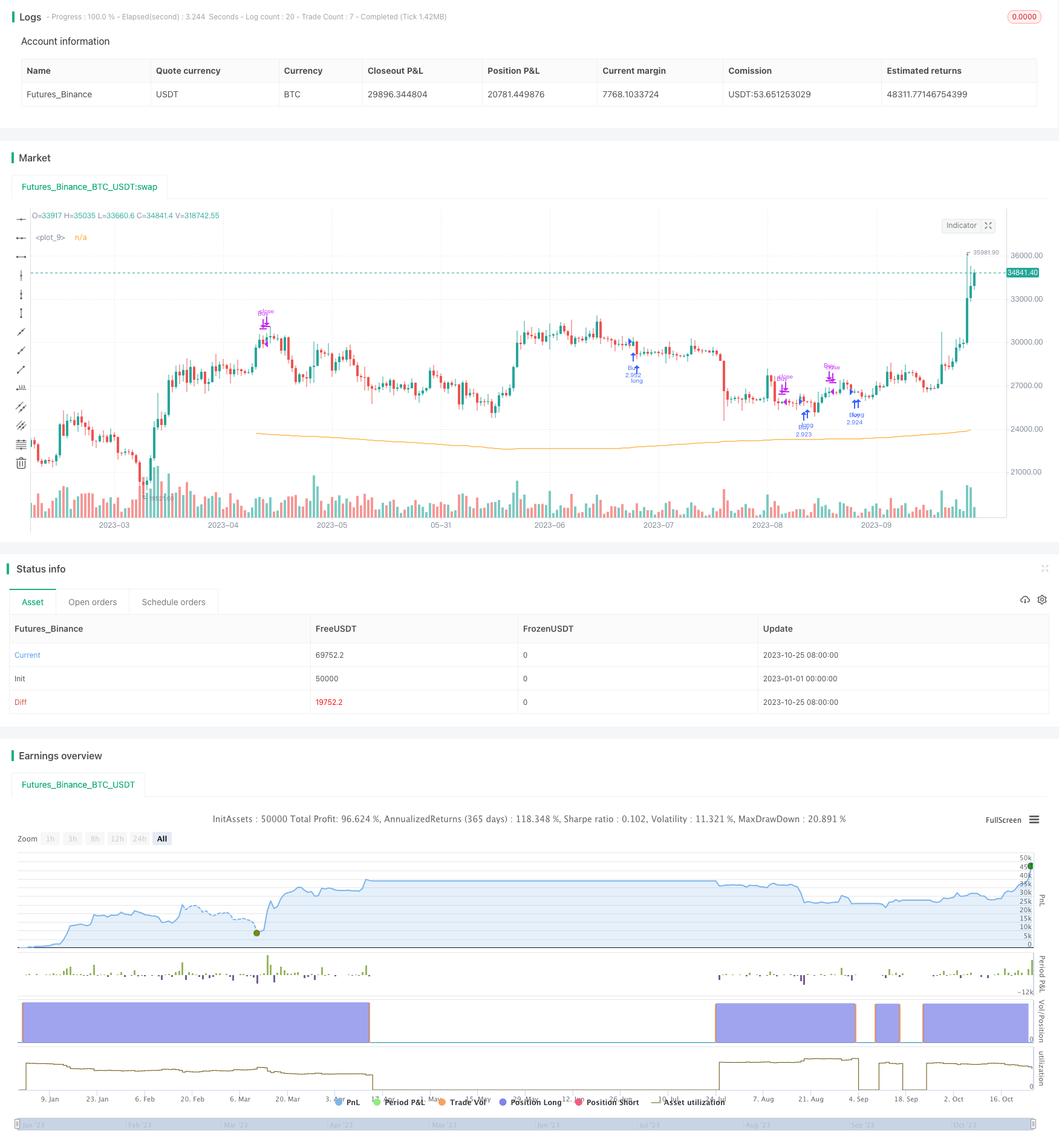
概述
本策略运用简单移动平均线判断趋势方向,在持续上涨行情中做多,持续下跌行情中做空,实现双向交易。
策略原理
本策略使用加权移动平均线VWMA判断市场趋势方向。当VWMA上涨时,做多;当VWMA下跌时,做空。
具体来说,策略首先计算一定周期的VWMA,然后判断VWMA是否上涨超过5天,如果是,则开仓做多;如果VWMA下跌超过5天,则开仓做空。平仓条件是VWMA方向反转超过5天后平仓。
为了计算月度和年度的收益表现,策略记录每月和每年的收益。通过比较本策略与市场基准收益,可以直观看到策略相对市场的表现。
优势分析
本策略具有以下优势:
使用VWMA判断趋势,可以有效过滤市场噪音,捕捉主要趋势。
仅在趋势确认后开仓,可以避免趋势反转带来的风险。
采用双向交易,无论行情上涨或下跌都可以盈利。
记录月度和年度收益,便于评估策略效果。
收益表中添加市场基准收益,可以直观比较策略与市场的相对表现。
风险分析
本策略也存在一些风险:
使用VWMA判断趋势可能存在滞后,可能错过趋势开始阶段的机会。
仅在趋势确认后开仓,可能错过部分Movement。
双向交易需要确定止损点,否则亏损可能加大。
大市场波动可能导致止损被触发,无法持有完整的趋势。
趋势反转判断可能不准确,导致亏损加大。
优化方向
本策略可以从以下方面进行优化:
优化VWMA周期参数,改善趋势判断。
调整确认趋势的天数,改善进出场时机。
添加止损策略,控制单笔亏损。
结合其他指标判断走势反转,提高确定性。
优化仓位管理,根据市场情况调整仓位。
考虑交易成本,设定MinimumProfit。
总结
本策略整体思路清晰简单,利用VWMA判断趋势方向,在趋势确认后双向交易,可以有效跟踪市场走势。但也存在一定风险,需要进一步测试和优化参数,调整进出场逻辑,并适当控制仓位规模。本策略为基础双向交易策略,为量化交易奠定了基础,值得进一步研究与改进。
/*backtest
start: 2023-01-01 00:00:00
end: 2023-10-26 00:00:00
period: 1d
basePeriod: 1h
exchanges: [{"eid":"Futures_Binance","currency":"BTC_USDT"}]
*/
//@version=4
strategy(title="Monthly Returns in Strategies with Market Benchmark", shorttitle="Monthly P&L With Market", initial_capital= 1000, overlay=true,default_qty_type = strategy.percent_of_equity, default_qty_value = 100, commission_type = strategy.commission.percent, commission_value = 0.1)
maLength= input(400)
wma= vwma(hl2,maLength)
uptrend= rising(wma, 5)
downtrend= falling(wma,5)
plot(wma)
if uptrend
strategy.entry("Buy", strategy.long)
else
strategy.close("Buy")//
///////////////////
// MONTHLY TABLE //
new_month = month(time) != month(time[1])
new_year = year(time) != year(time[1])
eq = strategy.equity
bar_pnl = eq / eq[1] - 1
bar_bh = (close-close[1])/close[1]
cur_month_pnl = 0.0
cur_year_pnl = 0.0
cur_month_bh = 0.0
cur_year_bh = 0.0
// Current Monthly P&L
cur_month_pnl := new_month ? 0.0 :
(1 + cur_month_pnl[1]) * (1 + bar_pnl) - 1
cur_month_bh := new_month ? 0.0 :
(1 + cur_month_bh[1]) * (1 + bar_bh) - 1
// Current Yearly P&L
cur_year_pnl := new_year ? 0.0 :
(1 + cur_year_pnl[1]) * (1 + bar_pnl) - 1
cur_year_bh := new_year ? 0.0 :
(1 + cur_year_bh[1]) * (1 + bar_bh) - 1
// Arrays to store Yearly and Monthly P&Ls
var month_pnl = array.new_float(0)
var month_time = array.new_int(0)
var month_bh = array.new_float(0)
var year_pnl = array.new_float(0)
var year_time = array.new_int(0)
var year_bh = array.new_float(0)
last_computed = false
if (not na(cur_month_pnl[1]) and (new_month or time_close + (time_close - time_close[1]) > timenow or barstate.islastconfirmedhistory))
if (last_computed[1])
array.pop(month_pnl)
array.pop(month_time)
array.push(month_pnl , cur_month_pnl[1])
array.push(month_time, time[1])
array.push(month_bh , cur_month_bh[1])
if (not na(cur_year_pnl[1]) and (new_year or time_close + (time_close - time_close[1]) > timenow or barstate.islastconfirmedhistory))
if (last_computed[1])
array.pop(year_pnl)
array.pop(year_time)
array.push(year_pnl , cur_year_pnl[1])
array.push(year_time, time[1])
array.push(year_bh , cur_year_bh[1])
last_computed := (time_close + (time_close - time_close[1]) > timenow or barstate.islastconfirmedhistory) ? true : nz(last_computed[1])
// Monthly P&L Table
var monthly_table = table(na)
getCellColor(pnl, bh) =>
if pnl > 0
if bh < 0 or pnl > 2 * bh
color.new(color.green, transp = 20)
else if pnl > bh
color.new(color.green, transp = 50)
else
color.new(color.green, transp = 80)
else
if bh > 0
color.new(color.red, transp = 20)
else if pnl < bh
color.new(color.red, transp = 50)
else
color.new(color.red, transp = 80)
if last_computed
monthly_table := table.new(position.bottom_right, columns = 14, rows = array.size(year_pnl) + 1, border_width = 1)
table.cell(monthly_table, 0, 0, "", bgcolor = #cccccc)
table.cell(monthly_table, 1, 0, "Jan", bgcolor = #cccccc)
table.cell(monthly_table, 2, 0, "Feb", bgcolor = #cccccc)
table.cell(monthly_table, 3, 0, "Mar", bgcolor = #cccccc)
table.cell(monthly_table, 4, 0, "Apr", bgcolor = #cccccc)
table.cell(monthly_table, 5, 0, "May", bgcolor = #cccccc)
table.cell(monthly_table, 6, 0, "Jun", bgcolor = #cccccc)
table.cell(monthly_table, 7, 0, "Jul", bgcolor = #cccccc)
table.cell(monthly_table, 8, 0, "Aug", bgcolor = #cccccc)
table.cell(monthly_table, 9, 0, "Sep", bgcolor = #cccccc)
table.cell(monthly_table, 10, 0, "Oct", bgcolor = #cccccc)
table.cell(monthly_table, 11, 0, "Nov", bgcolor = #cccccc)
table.cell(monthly_table, 12, 0, "Dec", bgcolor = #cccccc)
table.cell(monthly_table, 13, 0, "Year", bgcolor = #999999)
for yi = 0 to array.size(year_pnl) - 1
table.cell(monthly_table, 0, yi + 1, tostring(year(array.get(year_time, yi))), bgcolor = #cccccc)
y_color = getCellColor(array.get(year_pnl, yi), array.get(year_bh, yi))
table.cell(monthly_table, 13, yi + 1, tostring(round(array.get(year_pnl, yi) * 100)) + " (" + tostring(round(array.get(year_bh, yi) * 100)) + ")", bgcolor = y_color)
for mi = 0 to array.size(month_time) - 1
m_row = year(array.get(month_time, mi)) - year(array.get(year_time, 0)) + 1
m_col = month(array.get(month_time, mi))
m_color = getCellColor(array.get(month_pnl, mi), array.get(month_bh, mi))
table.cell(monthly_table, m_col, m_row, tostring(round(array.get(month_pnl, mi) * 100)) + " (" + tostring(round(array.get(month_bh, mi) * 100)) +")", bgcolor = m_color)